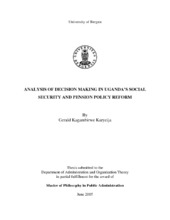| dc.description.abstract | This thesis argues that in order to understand Uganda’s social security reforms and how they were formulated, it is important to consider the patterns of interaction amongst the key actors. The major objective is to map out the decision making process of a select group of individuals working within limited time. This work is a qualitative study on the Social Security and Pensions Sector Stakeholder Transition Group (STG) deliberations between January 2003 and February 2004. The STG was appointed by the government of Uganda to come up with policy recommendations to reform the social security and pensions sector. Unraveling the actors involved in the STG and revealing the patterns of communication enabled me to address the following research questions: How did the actors arrive at these policy recommendations? What was the nature of participation among key actors in the STG? Why did the actors arrive at specific decisions? How did the actors arrive at specific decisions? What were the actors’ preferences? Did preferences change during the decision making process? Examining the patterns of interaction between the actors, their preferences, resources, time, and extent of communication, served as a basis for understanding policy formulation. Scholars such as Herbarmas, March and Olsen, Eriksen, Phillip and Zelikow, Gehring, inter alia proclaim that human action is a resultant of individual or group motivation; I drew from their studies and sought to explain policy formulation from the rationality perspective. With institutional oriented decision making, policies reflect context and specific policy objectives. Strategic oriented decision making reflects narrow preferences and compromise laden policy options. Consensus produces well reasoned and often new policy options. Data shows that the strategic oriented decision making style was more dominant, rule-following was next and the consensual was the least practiced by the STG. This paper concludes by suggesting that it is imperative to underscore the interaction patterns of policy formulators in order to get the essence of policies formulated. These forms of interaction do not only inform policies, but also determine the nature of established policies. These patterns are not absolute in themselves, but together, they led to the twenty four policy proposals for reforming the social security and pensions sector in Uganda. Finally, the decisions could either be incremental or radical in character. | en_US |
